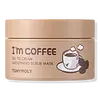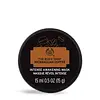What's inside
What's inside
 Key Ingredients
Key Ingredients

 Benefits
Benefits

 Concerns
Concerns

 Ingredients Side-by-side
Ingredients Side-by-side

Glycerin
HumectantCaprylic/Capric Triglyceride
MaskingWater
Skin ConditioningPolyglyceryl-3 Methylglucose Distearate
Emulsifying1,2-Hexanediol
Skin ConditioningCoffea Arabica Seed Powder 2%
AbrasivePolyglyceryl-3 Distearate
EmulsifyingPolyglyceryl-10 Myristate
Skin ConditioningCetearyl Alcohol
EmollientEuphorbia Cerifera Wax
Polyacrylate Crosspolymer-6
Emulsion StabilisingTheobroma Cacao Extract
Skin ConditioningDextrin
AbsorbentGlyceryl Stearate Citrate
EmollientEthylhexylglycerin
Skin ConditioningParfum
MaskingDiospyros Kaki Leaf Extract
Skin ProtectingButylene Glycol
HumectantCaffeine
Skin ConditioningVitis Vinifera Fruit Extract
Skin ConditioningPolygonum Cuspidatum Root Extract
AntioxidantCoffea Arabica Seed Extract
MaskingCarthamus Tinctorius Flower Extract
Skin ConditioningCastanea Crenata Shell Extract
Skin ConditioningCamellia Sinensis Leaf Extract
AntimicrobialZanthoxylum Piperitum Peel Extract
AntimicrobialAvena Sativa Kernel Extract
AbrasiveOryza Sativa Extract
AbsorbentHeptasodium Hexacarboxymethyl Dipeptide-12
Skin ConditioningGlycerin, Caprylic/Capric Triglyceride, Water, Polyglyceryl-3 Methylglucose Distearate, 1,2-Hexanediol, Coffea Arabica Seed Powder 2%, Polyglyceryl-3 Distearate, Polyglyceryl-10 Myristate, Cetearyl Alcohol, Euphorbia Cerifera Wax, Polyacrylate Crosspolymer-6, Theobroma Cacao Extract, Dextrin, Glyceryl Stearate Citrate, Ethylhexylglycerin, Parfum, Diospyros Kaki Leaf Extract, Butylene Glycol, Caffeine, Vitis Vinifera Fruit Extract, Polygonum Cuspidatum Root Extract, Coffea Arabica Seed Extract, Carthamus Tinctorius Flower Extract, Castanea Crenata Shell Extract, Camellia Sinensis Leaf Extract, Zanthoxylum Piperitum Peel Extract, Avena Sativa Kernel Extract, Oryza Sativa Extract, Heptasodium Hexacarboxymethyl Dipeptide-12
Polysorbate 20
EmulsifyingGlyceryl Stearate
EmollientPEG-100 Stearate
Propylene Glycol
HumectantSodium Chloride
MaskingIsopropyl Palmitate
EmollientEuglena Gracilis Extract
Skin ConditioningSucrose
HumectantCoffea Arabica Seed Powder
AbrasiveParfum
MaskingSesamum Indicum Seed Oil
EmollientTheobroma Cacao Seed Butter
EmollientButyrospermum Parkii Butter
Skin ConditioningXanthan Gum
EmulsifyingWater
Skin ConditioningCaffeine
Skin ConditioningPhenoxyethanol
PreservativePotassium Sorbate
PreservativeTocopherol
AntioxidantBiotin
AntiseborrhoeicCitric Acid
BufferingCaramel
Cosmetic ColorantPolysorbate 20, Glyceryl Stearate, PEG-100 Stearate, Propylene Glycol, Sodium Chloride, Isopropyl Palmitate, Euglena Gracilis Extract, Sucrose, Coffea Arabica Seed Powder, Parfum, Sesamum Indicum Seed Oil, Theobroma Cacao Seed Butter, Butyrospermum Parkii Butter, Xanthan Gum, Water, Caffeine, Phenoxyethanol, Potassium Sorbate, Tocopherol, Biotin, Citric Acid, Caramel
Ingredients Explained
These ingredients are found in both products.
Ingredients higher up in an ingredient list are typically present in a larger amount.
Caffeine is most associated with coffee, tea, and cacao. In skincare, it helps with calming inflammation and is rich in antioxidants.
While caffeine is used to treat cellulite and and dark circles, further studies are needed to prove this. It has been believed to help with these skin conditions due to its ability to dilate blood vessels and increase blood flow.
Some studies are looking into caffeine's ability to protect against UV rays.
Learn more about CaffeineCoffea Arabica Seed Powder is created by grinding down the beans of the coffee plant. (Coffee beans and seeds are the same thing).
Like other powders, it can have exfoliating properties due to the texture.
Parfum is a catch-all term for an ingredient or more that is used to give a scent to products.
Also called "fragrance", this ingredient can be a blend of hundreds of chemicals or plant oils. This means every product with "fragrance" or "parfum" in the ingredients list is a different mixture.
For instance, Habanolide is a proprietary trade name for a specific aroma chemical. When used as a fragrance ingredient in cosmetics, most aroma chemicals fall under the broad labeling category of “FRAGRANCE” or “PARFUM” according to EU and US regulations.
The term 'parfum' or 'fragrance' is not regulated in many countries. In many cases, it is up to the brand to define this term.
For instance, many brands choose to label themselves as "fragrance-free" because they are not using synthetic fragrances. However, their products may still contain ingredients such as essential oils that are considered a fragrance by INCI standards.
One example is Calendula flower extract. Calendula is an essential oil that still imparts a scent or 'fragrance'.
Depending on the blend, the ingredients in the mixture can cause allergies and sensitivities on the skin. Some ingredients that are known EU allergens include linalool and citronellol.
Parfum can also be used to mask or cover an unpleasant scent.
The bottom line is: not all fragrances/parfum/ingredients are created equally. If you are worried about fragrances, we recommend taking a closer look at an ingredient. And of course, we always recommend speaking with a professional.
Learn more about ParfumWater. It's the most common cosmetic ingredient of all. You'll usually see it at the top of ingredient lists, meaning that it makes up the largest part of the product.
So why is it so popular? Water most often acts as a solvent - this means that it helps dissolve other ingredients into the formulation.
You'll also recognize water as that liquid we all need to stay alive. If you see this, drink a glass of water. Stay hydrated!
Learn more about Water